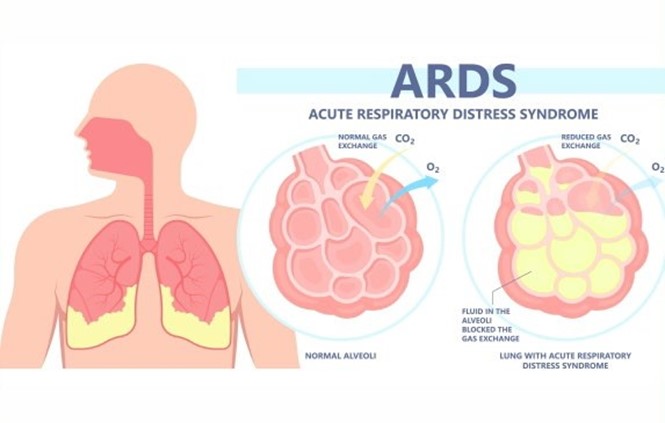A nurse is planning care for a client who has acute respiratory distress syndrome (ARDS). Which of the following interventions should the nurse include in the plan?
Administer low-flow oxygen continuously via nasal cannula.
Offer high-protein and high-carbohydrate foods frequently.
Place in a prone position.
Encourage oral intake of at least 3,000 mL of fluids per day.
The Correct Answer is C
Placing the client in a prone position improves oxygenation and ventilation by reducing lung compression, increasing lung expansion, and redistributing blood flow to better match ventilation.
a) Administering low-flow oxygen via nasal cannula is not sufficient for a client with ARDS, who requires
high levels of oxygenation and positive pressure ventilation to prevent alveolar collapse and hypoxemia.
b) Offering high-protein and high-carbohydrate foods frequently is beneficial for a client with ARDS, as it provides adequate nutrition and energy to support lung healing and prevent muscle wasting. However, it is not the priority intervention for improving respiratory function.
d) Encouraging oral intake of at least 3,000 mL of fluids per day is contraindicated for a client with ARDS, who is at risk of fluid overload and pulmonary edema. Fluid intake should be restricted and diuretics should be administered as prescribed to reduce fluid accumulation in the lungs.

Nursing Test Bank
Naxlex Comprehensive Predictor Exams
Related Questions
Correct Answer is ["A","D"]
Explanation
These responses are correct and explain how albuterol helps the client's breathing. Albuterol is a short- acting beta2-agonist that causes bronchodilation and relieves bronchospasm, which are the main causes of wheezing and dyspnea in clients who have asthma or COPD. By opening the airways, albuterol improves gas exchange and oxygenation.
b) The medication will decrease coughing episodes. This response is incorrect and does not explain how albuterol helps the client's breathing. Albuterol does not have a direct effect on coughing, which is a reflex response to irritation or obstruction of the airways. Coughing may be beneficial for clearing secretions and mucus from the lungs, but it may also cause bronchoconstriction and inflammation. The nurse should advise the client to use other measures to decrease coughing, such as drinking fluids, using a humidifier, or taking an expectorant.
c) The medication will reduce inflammation. This response is incorrect and does not explain how albuterol helps the client's breathing. Albuterol does not have an anti-inflammatory effect on the airways, which are often inflamed and swollen in clients who have asthma or COPD. Inflammation can contribute to airway obstruction and mucus production, which impair gas exchange and oxygenation. The nurse should inform the client that albuterol is used for quick relief of acute symptoms, but not for long-term control or prevention of inflammation. The client may need to use another medication, such as an inhaled corticosteroid, to reduce inflammation.
e) The medication will stimulate flow of mucus. This response is incorrect and does not explain how albuterol helps the client's breathing. Albuterol does not have a direct effect on mucus production or clearance, which are often increased in clients who have asthma or COPD. Mucus can cause airway obstruction and infection, which impair gas exchange and oxygenation. The nurse should advise the client to use other measures to stimulate flow of mucus, such as drinking fluids, using a humidifier, or taking an expectorant.

Correct Answer is D
Explanation
Keeping the drainage system below the level of the client's chest prevents backflow of fluid or air into the pleural space and maintains negative pressure in the system.
a) Disconnecting the chest tube from the drainage system during transport is dangerous and can cause pneumothorax, infection, or bleeding. The chest tube should remain connected to the drainage system at all times unless ordered by the provider.
b) Emptying the collection chamber prior to transport is unnecessary and can interfere with accurate measurement of drainage. The collection chamber should be emptied only when it is full or at the end of each shift.
c) Clamping the chest tube prior to transferring the client to a wheelchair is contraindicated and can cause tension pneumothorax, as it prevents air from escaping the pleural space. The chest tube should only be clamped for a brief period when changing the drainage system or checking for air leaks, and only with a provider's order.
Whether you are a student looking to ace your exams or a practicing nurse seeking to enhance your expertise , our nursing education contents will empower you with the confidence and competence to make a difference in the lives of patients and become a respected leader in the healthcare field.
Visit Naxlex, invest in your future and unlock endless possibilities with our unparalleled nursing education contents today
Report Wrong Answer on the Current Question
Do you disagree with the answer? If yes, what is your expected answer? Explain.
Kindly be descriptive with the issue you are facing.
